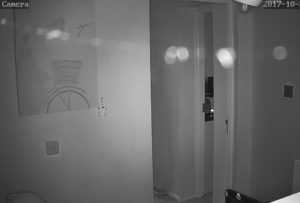When we are away, our house is looked after by security cameras. Whenever a camera detects motion in its view, it captures a set of photos and sends them to a dedicated mailbox. This setup adds to the peace of mind about the safety of our house while we are away, and comes with a nice bonus of observing random shots of the cat wandering around the house.
Our last trip added a piece of an action to the scheme. On the second day’s morning I woke up only to find ~200 camera e-mails in my inbox (the cat’s portraits typically account for 5-8). “Gotcha!”, I rubbed my hands. But I was too quick. All the 200+ photos, apart from 2-3 that actually captured the cat, were quite boring and very similar to each other: an empty room and some blurred spots in the centre. And no sign of burglars.

And that was only a beginning. Hour after hour, camera e-mails continued to come in, one in a minute. Finally, I gave up and returned to doing my business as usual. This decision proved to be tactically correct, as every morning since I woke up to find yet another 200-300 new camera e-mails in my inbox. Every morning I opened 2-3 emails randomly, observed the empty room and the spots, and proceeded to my business. At the time, I didn’t pay attention to the fact that all those messages were only coming in when it was night time at the camera time zone, and this fact was of big significance.
I managed to get back to this avalanche of alerts well after I returned back home. My findings appeared to be quite amusing.
In one of the rooms monitored by a camera a flying insect had found itself a shelter. When the lights went low in the evening, the camera switched from daytime to infrared mode, which resulted in a dim reddish backlight being turned on. Apparently, the bug was attracted to this backlight, and began to flutter around the camera. The camera detected the bug’s motion, and in full accordance with its setup activated the shutter and dispatched the pictures where instructed. During the daylight the camera was turning to a simple piece of furniture, the insect was losing its interest in it, and the flow of e-mails was stopping for a while – to start the cycle over in the dusk.
But that’s not the end of the story. To send out the photos, the cameras use a dedicated e-mail address at my hosting account. To prevent this e-mail account from being used by spammers, the number of messages that can be sent through is capped with 300 per day. The bug was apparently in a darn good shape, as it was managing to consume the whole message allowance way before noon – after which the mail server stopped accepting further messages from the cameras until the start of the next day. This meant that should the hypothetical burglars have planned their dark affairs for the afternoon, they could have avoided the scrutiny of the cameras, and make it off without being noticed – and all due to some tiny bug in the system (*).
The moral of this fable is,
(1) no matter how good at risk assessment you are, there always will be an unaccounted bug whose fluttering will turn all your mitigations down to a joke;
(2) sometimes the measures you expect to protect you (I’m speaking about my outgoing e-mail limits) may turn against you;
(3) (the most important of all!) leave much less food for your cats than you normally do when you go away, so they have an incentive to hunt for any nonsense fluttering around your cameras!
(*) They actually couldn’t – you don’t think that some levitating invertebrate would just knock my whole security system down, do you?